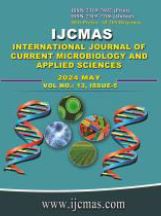


 National Academy of Agricultural Sciences (NAAS)
National Academy of Agricultural Sciences (NAAS)

|
PRINT ISSN : 2319-7692
Online ISSN : 2319-7706 Issues : 12 per year Publisher : Excellent Publishers Email : editorijcmas@gmail.com / submit@ijcmas.com Editor-in-chief: Dr.M.Prakash Index Copernicus ICV 2018: 95.39 NAAS RATING 2020: 5.38 |
BSI is caused by viable infectious microorganisms in the bloodstream (BS). Causing shock, disseminated intravascular coagulation, multiple organ failure, and demise. Extended-spectrum β-lactamases (ESBLs) are plasmid-mediated enzymes that pose a major therapeutic struggle in hospitalized and community-based patients these days. Aim of the study is to detect ESBL isolates in multidrug resistant clinical isolates from blood stream infections. Methods: The multidrug resistant organisms were isolated using the standard protocol followed in the laboratory followed by using double disc synergy method for ESBL detection. Results: Staphylococci were the most common among the gram-positive organisms (thirty-seven percent) followed by methicillin-resistant Staphylococcus aureus (twenty percent) and Staphylococcus epidermidis (5%). Escherichia coli (12%), Klebseilla pneumoniae (10%) and Pseudomonas aeruginosa (7%) were the widely known gram-negative organisms. Escherichia coli and Klebseilla pneumoniae were the main multi drug resistant organisms out of that 3 (80%) of the tested Escherichia coli (5) and 2 (50%) of the tested Klebseilla pneumoniae (4) were ESBL-producers. Conclusion: For effective management and prevention of drug resistance, reasonable antibiotic use, establishment of antibiotic policy, and timely BSI therapy are necessary. Finally, any delay in initiating appropriate antibiotic therapy has the potential to be fatal.
Ammerlaan H (2013). “Secular trends in nosocomial bloodstream infections: antibiotic-resistant bacteria increase the total burden of infection”. Clinical Infectious Diseases 56.6 (2013): 798-805. https://doi.org/10.1093/cid/cis1006
Anderson, D. J., J. J. Engemann, L. J. Harrell, Y. (2006). Predictors of mortality in patients with bloodstream infection due to ceftazidime-resistant Klebseilla pneumoniae. Antimicrob. Agents Chemother. 50:1715–1720. https://doi.org/10.1128/AAC.50.5.1715-1720.2006
Berenholtz S M (2004) “Eliminating catheter-related bloodstream infections in the intensive care unit”. Critical Care Medicine 32.10: 2014-2020.
Carey I M, Critchley J A, DeWilde S (2018). Risk of Infection in Type 1 and Type 2 Diabetes Compared With the General Population: A Matched Cohort Study. Diabetes Care: 41: 513-21. https://doi.org/10.2337/dc17-2131
Clinical and Laboratory Standards Institute. CLSI Document M100-S27. Wayne, PA: Clinical and Laboratory Standards Institute; 2017. Performance Standards for Antimicrobial Susceptibility Testing: Twenty-Fourth Informational Supplement. [Google Scholar]
Clinical and Laboratory Standards Institute. Performance standards for antimicrobial susceptibility testing, CLSI, Wayne, P A (2005) Google Scholar
CLSI. CLSI Document M47-A. Wayne, P A: Clinical and Laboratory Standards Institute; 2017. Principles and Procedures for Blood Cultures; approved Guideline. [Google Scholar]
Cohen J, Vincent J L, Adhikari N K J. (2015) Sepsis: a roadmap for future research. Lancet Infect Dis.;15:581–614. https://doi.org/10.1016/S1473-3099(15)70112-X
Gilbert, D. N., R. C. Moellering, Jr M. A. Sande. (2013). The Sanford guide to antimicrobial therapy, 33rd ed. Antimicrobial Therapy, Inc., Hyde Park, VT
Laupland, K. B., (2013) “Incidence of bloodstream infection: a review of population-based studies,” Clinical Microbiology and Infection, vol. 19, no. 6, pp. 492–500. https://doi.org/10.1111/1469-0691.12144
Mario Tumbarello M et al., Bloodstream Infections Caused by Extended-Spectrum--Lactamase-Producing Klebseilla pneumoniae: Risk Factors, Molecular Epidemiology, and Clinical Outcome. Antimicrobial Agents and Chemotherapy, Feb. 2006, p. 498–504. https://doi.org/10.1128/AAC.50.2.498-504.2006
Prabhu K, Bhat S, Rao S. (2010) Bacteriologic profile and antibiogram of blood culture isolates in a pediatric care unit. J Lab Physicians;2:85-8. https://doi.org/10.4103/0974-2727.72156
Shakya P, Shrestha D, Maharjan E, Sharma V K, Paudyal R (2017) “ ESBL production among E.coli and Klebseilla spp. Causing urinary tract infection: A hospital based study. Apr 28:11:23-30. https://doi.org/10.2174/1874285801711010023
Thaden J T, Park L P, Maskarinec S A, Ruffin F (2017) Results from a 13-year prospective cohort study show increased mortality associated with bloodstream infections caused by Pseudomonas aeruginosa compared to other bacteria. Antimicrob Agents Chemother;61:e02671–16. https://doi.org/10.1128/AAC.02671-16
Viscoli, C., (2016) “Bloodstream Infections: the peak of the iceberg,” Virulence, vol. 7, no. 3, pp. 248–251. https://doi.org/10.1080/21505594.2016.1152440
Woodford, N., P. M. Tierno, Jr., K. Young, L. Tysall, M. F. Palepou, E. Ward, R. E. Painter, D. F. Suber, D. Shungu, L. L. Silver, K. Inglima, J. Kornblum, and D. M. Livermore. 2004. Outbreak of Klebseilla pneumoniae producing a new carbapenem-hydrolyzing class A beta-lactamase, KPC-3, in a New York Medical Center. Antimicrob. Agents Chemother. 48:4793–4799. https://doi.org/10.1128/AAC.48.12.4793-4799.2004
 |
 |
 |
 |
 |